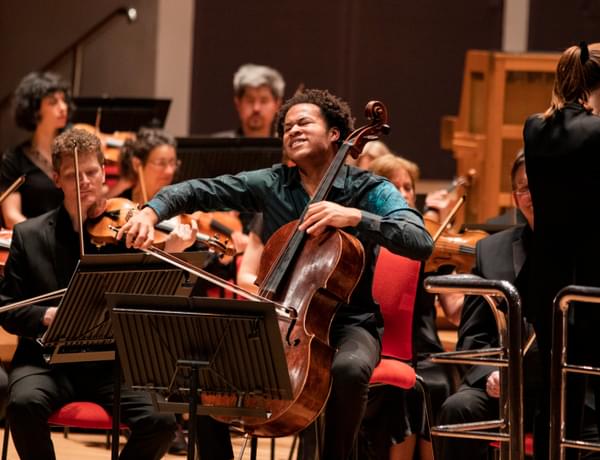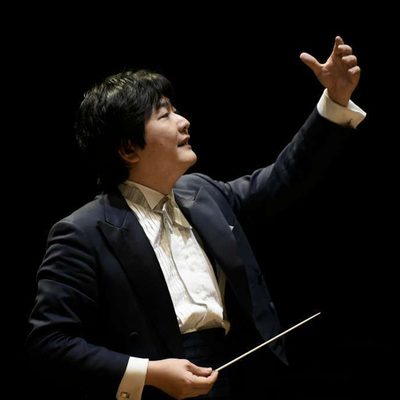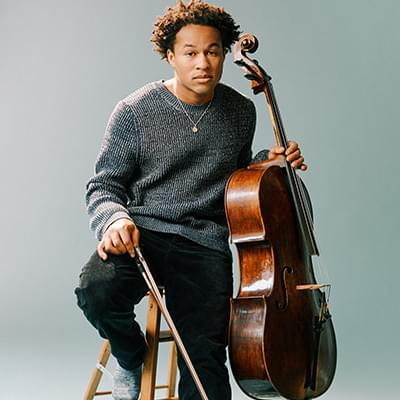Kazuki conducts Elgar & Tchaikovsky

Full programme
- Elgar, Cello Concerto (30mins)
- Tchaikovsky, Symphony No.5 (47mins)
Performers

Kazuki Yamada
Conductor
Sheku Kanneh-Mason
Cello
Introduction
I’m really looking forward to today’s concert. The CBSO are an orchestra that I feel very at home with – having performed together quite a few times now, I feel like I have a really great relationship with the orchestra.
When I last worked with Kazuki, I played Shostakovich’s First Cello Concerto and I’ve been really looking forward to playing with him again since then. I think he is a wonderful fit for the CBSO – he is always keen to find something special in the music, something that I always try to look for too in my playing, so I think it will be a very exciting collaboration. His enthusiasm for life and music is very infectious!
I’ve played Elgar’s Cello Concerto many times, yet each time is a new experience for me. It’s full of detail and questions so it’s taken me playing it a lot to really get to know the piece, yet I still feel like I’m discovering new corners of the piece when I revisit it.
The violas first introduce the main melody at the beginning of the piece and the melody then interweaves throughout the orchestra. Listen out for how it grows throughout the piece, it’s interesting to follow how it develops both emotionally and in the orchestration. I also love playing the second movement; it combines excitement, playfulness and nervousness in one and moves between these moods very quickly, really keeping us on our toes.
We go on tour to Japan after playing in this concert and it will be very special to go with a piece and an orchestra that I know very well. To also hear the orchestra play Tchaikovsky’s Fifth Symphony will be such a treat as it’s one of my favourites! I hope you enjoy it too.
Sheku Kanneh-Mason
Cello
Programme notes
The Cello Concerto is one of Elgar’s last works – and one of his best. It is a gorgeously rich blend of melody and melancholy, with one of the most powerful opening bars ever written for the cello. What an absolute treat to hear Sheku Kanneh-Mason in the solo role. Tchaikovsky’s Fifth Symphony tackles fate head-on right up to its triumphant finale.
Cello Concerto
Edward Elgar (1857-1934)
Given how highly-regarded Elgar’s Cello Concerto has become, it is startling to discover that the critical reception after its 1919 premiere ranged from lukewarm to chilly . ‘The first impression was one of disappointment,’ wrote HC Colles in The Musical Times; others found it ‘thin’ and ‘depressing.’ Inadequate time for rehearsing was partly to blame, as well as – according to one reviewer – a lack of audience interest in new works. It has had, though, a major revival in the decades since, largely due to its famous championing by a young Jacqueline Du Pré. Reviewers of her 1967 recording found the combination of her youth and Elgar’s relative age (this was his last major work, composed when he was sixty-two) incredibly poignant. The ’autumnal’ associations of the piece, as well as its nostalgic quality, pervade today. It was indeed composed in the shattered aftermath of World War I and could easily be an elegy for a lost world. In 1986 it was the theme tune to the ITV series Paradise Postponed which was partly about regret for a vanished, specifically ‘English’, way of life.
However it might be interpreted, the Cello Concerto is an undeniably moving, elegantly-constructed piece, rich in themes, and with a distinctive characterisation of the solo part. Jerrold Northrop Moore describes the cellist here as a ‘lonely solo spirit’. In every movement, apart from the final one, the cello opens with an exploratory, sometimes tentative passage as if testing the water before diving in. Even in the boisterous finale, after the strings give a spirited introduction, the cello takes off on an improvisatory journey before joining back in. The themes are melancholy yet stirringly beautiful, notably the rolling melody of the first movement and the richly scored theme of the Adagio. In between is a scurrying ‘Allegro molto’, while the energy of the finale is interrupted by a passage of extraordinary yearning. The cello looks back, briefly, to the striking opening chords before this powerfully expressive concerto draws to an emphatic close.
Symphony no.5
Pyotr Ilyich Tchaikovsky (1840-1893)
Tchaikovsky was a prolific composer, possessed of a mercurial, turbulent character and often a powerful sense of self-doubt. His life was punctuated by dramatic relationships, such as his short-lived marriage. But in the summer of 1888 he was in tentatively good spirits, embarking on his fifth symphony while on holiday in Frolovskoe, not far from Moscow. Despite having worried to his brother Modest that his talent was drying up, he wrote shortly afterwards to patron Nadezhda von Meck ‘I cannot tell you what a pleasure it has been to watch my flowers grow and see daily – even hourly – new blossoms coming out….I have been working with good results, for half the symphony is now orchestrated.’
The symphony continued to bloom and grow, forming its structure and atmosphere around a dominant motif first heard at the start, then making appearances throughout. Tchaikovsky noted that the symphony’s ‘programme’ suggested ‘Complete resignation before Fate, or…the inscrutable predestination of Providence,’ and the opening theme is frequently described as the ‘fate’ motif. The symphony is abundantly rich in other melodies, with four significant themes in the first movement alone, ranging from jaunty to yearning. Yet most of them bear at least some resemblance to the fate motif, either through a dotted, stuttering rhythm or a downward slope of melody. The opening movement ends not with a bang, but with an ominous, whispered descent into the depths of the orchestra.
The second movement begins with one of the most famous themes in the orchestral repertoire, initially on the solo horn (any resemblance to the famous ‘Annie’s Song,’ is – according to John Denver – entirely accidental). A clarinet joins in with a soulful counter-melody, followed by an oboe determined to cheer things up with a new melody. These themes, along with a pulsing underpinning from the rest of the orchestra, lead Tchaikovsky towards the romantic territory of his Romeo and Juliet overture composed some eight years earlier. The ‘fate’ motif dramatically intrudes into atmosphere twice during the movement, the first time seeming to send the orchestra into shock before it regathers with the opening theme. The delicate, dance-like third movement borrows its melody from an Italian street-song, and the ‘fate’ motif takes more or less a back seat. Yet it is strongly to the fore in the finale, where it eventually transforms into a major key. For some, this is a ‘triumph’ over fate, the trumpets blasting heroically over the ensemble. Yet Tchaikovsky was not especially happy with the conclusion, writing that it had ‘a certain excess of gaudiness and insincerity.’ Yet, perhaps with ears attuned to ironic overstatement (such as at the end of Shostakovich’s Fifth Symphony some years later), we might feel those final E major chords have a darkly sinister rather than ‘gaudy’ edge.
© Lucy Walker
Featured image © Andrew Fox